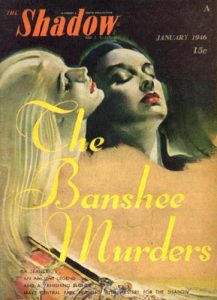 The Shadow was introduced to the public on July 31, 1930. The character was the mysterious narrator for THE DETECTIVE STORY HOUR, a CBS radio program sponsored by the Street & Smith pulp chain.
The Shadow was introduced to the public on July 31, 1930. The character was the mysterious narrator for THE DETECTIVE STORY HOUR, a CBS radio program sponsored by the Street & Smith pulp chain.
When the publisher’s business manager, Henry Ralston, began to hear from newsdealers that their customers were not asking for DETECTIVE STORY MAGAZINE, but “that Shadow magazine,” he decided that the time might be ripe for the revival of the single-character magazine.
Founded in 1855, Street & Smith had achieved great success publishing dime novels featuring continuing characters such as Buffalo Bill, Frank Merriwell, and detective Nick Carter. Ralston envisioned a modernized version of the dime novel detective as the lead for the new pulp magazine.
Providing an unpublished Carter story to the editorial staff, Ralston suggested that they simply change Nick Carter to The Shadow and he would take care of the rest. He felt the pulp would last no more than four quarterly issues, just enough to establish a trademark on the character.
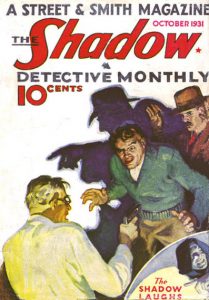 When THE SHADOW: A DETECTIVE MAGAZINE was launched on March 6, 1931, Street & Smith was hedging its bets. Thinking the magazine would have a short lifespan, editor Frank Blackwell offered the pulp’s lead novel to a relatively unknown writer — Philadelphia newspaper reporter Walter B. Gibson.
When THE SHADOW: A DETECTIVE MAGAZINE was launched on March 6, 1931, Street & Smith was hedging its bets. Thinking the magazine would have a short lifespan, editor Frank Blackwell offered the pulp’s lead novel to a relatively unknown writer — Philadelphia newspaper reporter Walter B. Gibson.
The first issue’s cover art was a recycled Modest Stein painting from the October 1, 1919 issue of THE THRILL BOOK. Street & Smith followed a similar tack three months later, reusing John Coughlin’s cover art for the December 2, 1919 issue of DETECTIVE STORY MAGAZINE.
After the first two issues of the new Street & Smith magazine flew off the stands, the publisher realized that it had a hit on its hands. Writing as Maxwell Grant, Walter Gibson had refashioned the sinister narrator of THE DETECTIVE STORY HOUR into the first pulp hero.
Within a year, the magazine began appearing twice a month. Within two years, it began spawning a host of imitators — THE PHANTOM DETECTIVE, THE SPIDER, SECRET AGENT “X,” and Street & Smith’s own DOC SAVAGE MAGAZINE and THE AVENGER. Lasting 325 issues and spanning eighteen years, THE SHADOW magazine ran until the Summer of 1949.
Although Gibson’s mysterious crime-busting super-sleuth was certainly a major selling point for the early issues of THE SHADOW pulp, the magazine was a complete package.
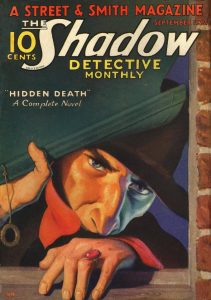 Beginning with the pulp’s third issue, THE SHADOW: A DETECTIVE MONTHLY began to feature cover art by Jerome and George Rozen. Although the former would be the magazine’s first original cover artist, it was his brother George who would become the Street & Smith hero pulp’s most renowned cover artist. George Rozen would paint nearly two hundred covers for the pulp — including the magazine’s final issue, dated Summer 1949. His art would also grace the covers of the 1942 and 1943 issues of THE SHADOW ANNUAL and the first six issues of Street & Smith’s SHADOW COMICS.
Beginning with the pulp’s third issue, THE SHADOW: A DETECTIVE MONTHLY began to feature cover art by Jerome and George Rozen. Although the former would be the magazine’s first original cover artist, it was his brother George who would become the Street & Smith hero pulp’s most renowned cover artist. George Rozen would paint nearly two hundred covers for the pulp — including the magazine’s final issue, dated Summer 1949. His art would also grace the covers of the 1942 and 1943 issues of THE SHADOW ANNUAL and the first six issues of Street & Smith’s SHADOW COMICS.
After George Rozen left the magazine, Graves Gladney took on the pulp’s cover chores. Beginning with the April 1, 1939 number and running through the September 15, 1941 issue, Gladney painted sixty covers for the Street & Smith magazine. Still later, it would be Modest Stein — the pulp’s first cover artist — who would handle the brush. Stein would create over forty covers for THE SHADOW. Other artists who contributed cover art to the magazine were Charles Coll, Charles DeFeo, Bob Powell, Walter Swenson, William Timmins, and possibly Charles Ravel. There was also one photographic cover.
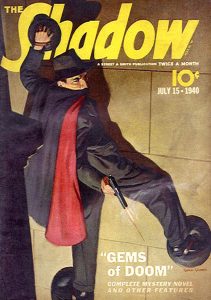 Completing the entire package was the magazine’s interior artists. Over its nearly two decades of publication, THE SHADOW was blessed with the pen and ink work of Edd Cartier, Tom Lovell, Earl Mayan, Paul Orban, and George Wert. These five artists, plus a few others, lent their talents to make Street & Smith’s THE SHADOW the bestselling hero pulp on America’s newsstands.
Completing the entire package was the magazine’s interior artists. Over its nearly two decades of publication, THE SHADOW was blessed with the pen and ink work of Edd Cartier, Tom Lovell, Earl Mayan, Paul Orban, and George Wert. These five artists, plus a few others, lent their talents to make Street & Smith’s THE SHADOW the bestselling hero pulp on America’s newsstands.
On Thursday, August 19, join PulpFest 2021 and pulp art scholar David Saunders for “Shadow Artists — Inside & Out,” a look at the artists who helped turn THE SHADOW pulp into a complete package. Our presentation will take place at the DoubleTree by Hilton Hotel Pittsburgh – Cranberry, beginning at 8:10 PM.
David Saunders is the winner of the Lamont Award, a “retro” award especially presented in 2016 to recognize his substantial service to the pulp community over the years. Since a limited edition of thirty-six numbered and signed prints — designed and painted by David — serves as the Munsey Award, it was decided to honor David’s significant contributions to the pulp world with one of the few remaining copies of Pulpcon‘s Lamont Award.
David is, quite probably, the foremost scholar of American pulp artists. His free public website, Field Guide to Wild American Pulp Artists, has over three hundred biographical profiles of these creators of popular culture. Additionally, he has written biographical profiles of artists for ILLUSTRATION MAGAZINE and several coffee-table art books on pulp artists.
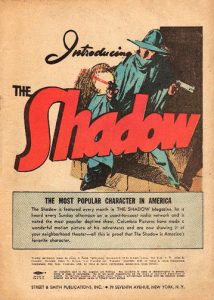 An award-winning artist himself, David is the son of the late pulp artist, Norman Saunders. A top pulp magazine cover artist, Norman Saunders painted 867 pulp covers for almost every title and publisher, a number greater than any other artist. To find out more about David and Norman Saunders, please visit davidsaunders.biz and normansaunders.com.
An award-winning artist himself, David is the son of the late pulp artist, Norman Saunders. A top pulp magazine cover artist, Norman Saunders painted 867 pulp covers for almost every title and publisher, a number greater than any other artist. To find out more about David and Norman Saunders, please visit davidsaunders.biz and normansaunders.com.
The general public is welcome to attend our evening programming events. To learn more about our programming schedule, please click the Programming button at the top of this page.
For those who also want to enjoy our dealers’ room, you can join PulpFest by clicking the Registration button at the top of this page. And don’t forget to book a room at the DoubleTree. They’re going fast!
A major reason for The Shadow magazine’s popularity was its cover art, created by such talented artists as John A. Coughlin — the creator of our featured image; Modest Stein, the famed LOVE STORY MAGAZINE who painted the cover art for the January 1946 number; Jerome Rozen, contributor of four covers, including the October 1931 issue; George Rozen, the artist responsible for the “Hidden Death” cover painting, featured on the September 1932 number; and Graves Gladney, the cover artist for the July 15, 1940 issue.
Another reason for the popularity of THE SHADOW MAGAZINE was its interior artists over the years, pen and ink illustrators such as Edd Cartier. The artist’s “Introducing The Shadow” appeared in the first issue of Street & Smith’s SHADOW COMICS, dated March 1940. Cartier’s artwork is a colorized reprint of The Shadow firing his guns from a doorway that originally appeared in “Shiwan Khan Returns,” the lead novel for the December 1939 issue of THE SHADOW.
Incidentally, the cover art used for the first issue of Street & Smith’s SHADOW COMICS was George Rozen’s painting for the November 1932 issue of THE SHADOW MAGAZINE, illustrating the Walter B. Gibson novel, “Dead Men Live.”
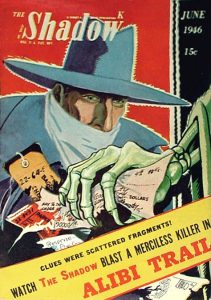 Later in its run, the cover art for THE SHADOW was handled by a variety of artists, including Charles Coll, who contributed two covers — including the June 1946 number — plus the cover art for THE SHADOW ANNUAL of 1947. Better known for his work on Street & Smith’s DOC SAVAGE COMICS, SHADOW COMICS, and SUPER-MAGICIAN COMICS, Coll was a staff artist at the New York art studio of Jack Binder. He drew both interior and cover art for the Street & Smith comic book line.
Later in its run, the cover art for THE SHADOW was handled by a variety of artists, including Charles Coll, who contributed two covers — including the June 1946 number — plus the cover art for THE SHADOW ANNUAL of 1947. Better known for his work on Street & Smith’s DOC SAVAGE COMICS, SHADOW COMICS, and SUPER-MAGICIAN COMICS, Coll was a staff artist at the New York art studio of Jack Binder. He drew both interior and cover art for the Street & Smith comic book line.







